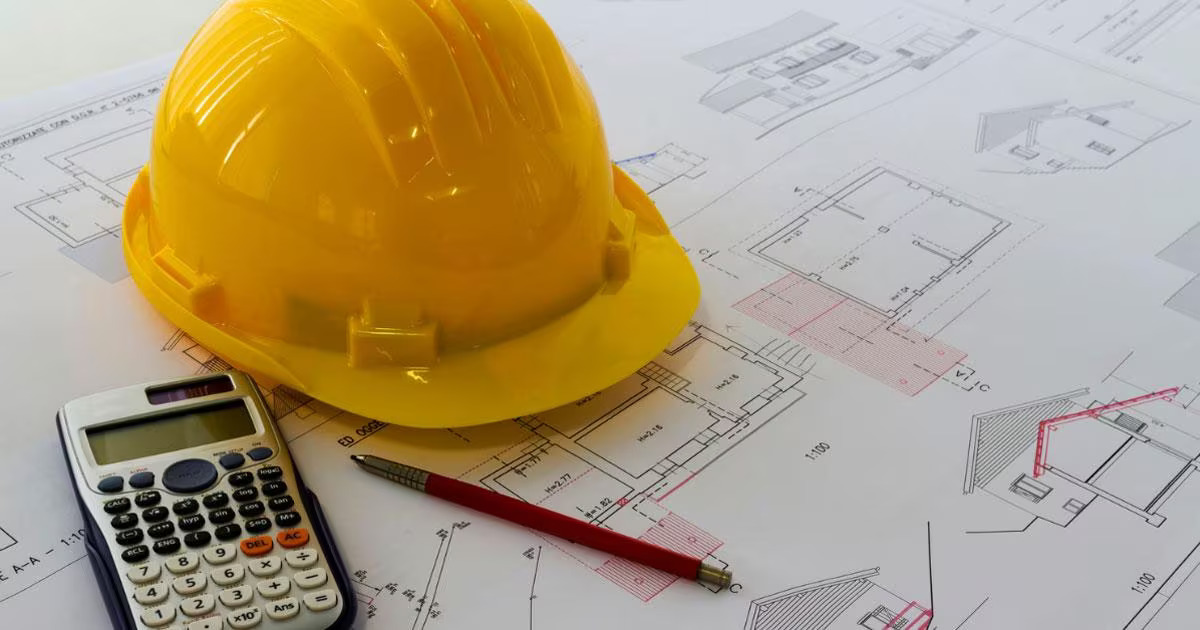Home>diy>Building & Construction>How To Run The Accounting In A Construction Business


Building & Construction
How To Run The Accounting In A Construction Business
Modified: August 17, 2024
Learn how to effectively manage accounting in your building construction business with helpful tips and strategies for financial success.
(Many of the links in this article redirect to a specific reviewed product. Your purchase of these products through affiliate links helps to generate commission for Storables.com, at no extra cost. Learn more)
Introduction
Running an accounting system is crucial for any business, and the construction industry is no exception. In fact, having a well-organized and efficient accounting system is vital for the success of a construction business. It helps track expenses, manage payroll, handle accounts receivable and payable, and ensures financial stability.
Setting up and maintaining an effective accounting system can be a daunting task, especially for those who are unfamiliar with accounting principles. However, with the right guidance and understanding, you can streamline your financial operations and make informed business decisions.
In this article, we will walk you through the process of setting up and running the accounting system for your construction business. We will cover important aspects such as creating a chart of accounts, tracking expenses, managing payroll, handling accounts receivable and payable, generating reports and analysis, and complying with tax regulations.
By the end of this article, you will have a clear understanding of how to establish an efficient accounting system that will support the financial health and growth of your construction business.
Key Takeaways:
- Efficient accounting systems are crucial for construction businesses. Setting up the right software, tracking expenses, managing payroll, and handling accounts receivable and payable are essential for financial stability and profitability.
- Regular reporting, analysis, and proactive tax planning are vital for informed decision-making and compliance. By leveraging insights and staying updated, construction businesses can optimize financial health and success.
Read more: How To Run A Bounce House Business
Setting Up the Accounting System
Before diving into the nitty-gritty of accounting, it’s important to lay the groundwork for your construction business’s accounting system. The first step is to choose the right accounting software that suits your specific needs.
There are many accounting software options available in the market, such as QuickBooks, Xero, and FreshBooks, which offer features tailored to the construction industry. Consider factors like scalability, ease of use, reporting capabilities, and compatibility with other tools when selecting the software that best fits your business.
Once you have chosen the software, the next step is to set up your chart of accounts. This is a categorized list of all the financial accounts that your business will use to record transactions. It provides a structured system for tracking and organizing your income, expenses, assets, liabilities, and equity.
Your chart of accounts should be customized to reflect the unique aspects of your construction business. It should include categories such as project expenses, materials, labor costs, subcontractor payments, equipment rentals, overhead expenses, and more. This will ensure that you can accurately categorize and analyze your financial data.
Additionally, you should establish a system for organizing and storing all your financial documents, such as invoices, purchase orders, receipts, and contracts. This could be a physical filing system or a digital document management software.
It’s also a good idea to create a schedule for regular financial tasks, such as reconciling bank statements, reviewing financial reports, and preparing tax documents. This will help you stay on top of your financial responsibilities and ensure that your accounting system remains accurate and up to date.
Finally, consider the security of your accounting system. Implement internal controls to prevent fraud or misappropriation of funds. Regularly back up your data to protect against data loss or system failures.
By setting up your accounting system with a strong foundation, you will be well-equipped to track and manage your construction business’s financial transactions effectively.
Chart of Accounts
The chart of accounts is a crucial component of any accounting system, as it provides a framework for categorizing and organizing financial transactions. In the context of a construction business, the chart of accounts should be tailored to capture the unique aspects of your industry.
When creating your chart of accounts, start by identifying the main categories that will encompass your financial transactions. These could include revenue, expenses, assets, liabilities, and equity. Within each category, you can further break down the accounts into more specific subcategories.
For example, under the revenue category, you may have subcategories such as sales for different types of construction projects (residential, commercial, etc.), change orders, and reimbursements. Under the expenses category, you can have subcategories for labor, materials, subcontractor payments, equipment rentals, insurance, permits, and overhead expenses.
In addition to these category-specific accounts, you may also want to include accounts that track project-specific expenses. This can help you monitor the financial performance of individual construction projects and ensure that each project remains profitable.
Consider including accounts for each project’s direct and indirect costs, such as labor, materials, equipment, permits, and design fees. This will allow you to track the costs associated with each project and compare them to the revenue generated, giving you valuable insights into project profitability.
Another important aspect of the chart of accounts is assigning appropriate account numbers to each account. This numbering system should follow a logical order, making it easier to locate and identify specific accounts during data entry, reporting, and analysis. Some businesses use a numerical system, where the first few digits represent the category, followed by sequential numbering within each category.
Regularly reviewing and refining your chart of accounts is essential to maintain the accuracy and relevance of your accounting system. As your construction business evolves and grows, you may need to add or modify accounts to reflect changes in your operations or comply with new accounting standards or regulations.
By carefully designing and maintaining your chart of accounts, you will have a solid foundation for tracking and analyzing your construction business’s financial transactions, allowing you to make informed decisions and strategize for future success.
Tracking Expenses
Tracking expenses is a crucial part of managing the financial health of your construction business. It allows you to monitor your costs, identify areas of overspending, and make informed decisions to optimize your profitability. Here are some key strategies for effectively tracking expenses:
1. Categorize expenses: Create expense categories specific to your construction business, such as payroll, materials, subcontractors, equipment rentals, permits, and overhead costs. Ensure that each expense is properly categorized to facilitate accurate financial reporting and analysis.
2. Use digital tools: Consider utilizing construction-specific accounting software or expense management apps to streamline the expense tracking process. These tools can automate data entry, categorization, and generate reports, saving you valuable time and reducing the risk of errors.
3. Capture receipts: Retain all receipts and invoices for expenses related to your construction business. Scanning or digitally storing them ensures you have a reliable record for future reference, expense reconciliation, and tax compliance purposes.
4. Implement a system for expense approvals: Establish clear protocols for approving expenses, such as setting spending limits and requiring the appropriate level of authorization for different expense categories. This helps prevent unauthorized or unnecessary spending.
5. Track labor costs: Labor is a significant expense in the construction industry. Implement a system to accurately track and allocate labor costs to specific projects or cost codes. This will enable you to monitor labor productivity, estimate project costs, and ensure accurate job costing.
6. Monitor subcontractor expenses: If your construction business employs subcontractors for certain tasks, track their expenses separately. This will allow you to analyze and compare subcontractor costs, ensuring fair pricing and identifying potential savings opportunities.
7. Reconcile bank and credit card statements: Regularly reconcile your bank and credit card statements to ensure that all expenses are properly recorded in your accounting system. This helps identify any errors or discrepancies, ensuring the accuracy of your financial records.
8. Periodic expense review: Conduct regular reviews of your expenses to identify cost-saving opportunities. Look for areas where you can negotiate better terms with suppliers, consolidate purchases, or explore alternative vendors to reduce costs without compromising quality.
9. Budgeting and variance analysis: Develop a budget for your construction business and compare actual expenses against budgeted amounts. Analyze variances to understand the reasons behind them and take corrective actions as needed.
10. Seek professional advice: Consider consulting with an accountant or financial advisor who specializes in the construction industry. They can provide valuable insights and guidance on best practices for expense tracking and help you maximize your financial efficiency.
By implementing these strategies and maintaining a diligent approach to expense tracking, you can effectively manage costs, improve profitability, and make informed decisions to drive the success of your construction business.
Managing Payroll
Managing payroll is a critical aspect of running a construction business. It involves accurately calculating and disbursing wages to your employees while complying with labor laws and tax regulations. Here are some essential steps to effectively manage payroll:
1. Classify employees correctly: Ensure that your construction business properly classifies employees as either full-time or part-time workers, as well as distinguishing between employees and independent contractors. This classification is important for determining payroll taxes and benefits eligibility.
2. Maintain accurate employee records: Keep detailed records for each employee, including their personal information, employment agreements, tax forms (such as W-4), and any relevant documents required for payroll processing.
3. Choose a payroll system: Select a payroll system that suits the needs of your construction business. This can be done either through an in-house payroll software or outsourcing payroll to a third-party provider. Consider factors such as cost, functionality, user-friendliness, and integration with other accounting systems.
4. Set up a payroll schedule: Establish a regular schedule for processing payroll. This includes determining the frequency of pay periods (weekly, bi-weekly, or monthly) and ensuring that paychecks are distributed on time. Be mindful of local labor laws and ensure compliance with minimum wage requirements and overtime regulations.
5. Calculate gross pay: Calculate each employee’s gross pay based on their hourly rate or salary, taking into account any overtime, bonuses, or commissions they may be entitled to. It is crucial to accurately calculate pay to avoid discrepancies and ensure fairness.
6. Deduct payroll taxes: Withhold applicable payroll taxes from employee wages. This includes federal and state income taxes, social security taxes, and Medicare taxes. Stay updated with tax rates and ensure timely remittance of payroll taxes to the appropriate government agencies.
7. Handle employee benefits: Process any deductions for employee benefits such as health insurance, retirement plans, and other voluntary deductions. Ensure accurate calculations and timely payments to benefit providers.
8. Prepare payroll reports: Generate payroll reports that provide a detailed breakdown of employee wages, taxes withheld, and any deductions or reimbursements. These reports serve as essential records for audits and financial analysis.
9. Stay compliant with labor laws: Familiarize yourself with labor laws and regulations specific to the construction industry. This includes requirements related to overtime, meal breaks, and record-keeping. Regularly review and update your payroll processes to ensure compliance.
10. Pay attention to payroll year-end tasks: Complete year-end payroll tasks such as generating W-2 forms for employees, reconciling payroll tax forms, and reporting employee wages to the relevant tax authorities. Stay organized and plan ahead to meet all necessary deadlines.
Managing payroll in a construction business requires attention to detail, accuracy, and compliance with various regulations. By following these steps and employing reliable payroll practices, you can ensure that your employees are paid correctly and your business remains in good standing with tax authorities.
Tip: Use construction-specific accounting software to track job costs, manage contracts, and handle complex billing and invoicing. This will help streamline your accounting processes and ensure accuracy in financial reporting.
Handling Accounts Receivable
Efficiently managing accounts receivable is crucial for maintaining a healthy cash flow in your construction business. Accounts receivable refers to the money owed to your company by customers or clients for goods or services provided. Here are some essential strategies for handling accounts receivable:
1. Establish clear payment terms: Clearly communicate your payment terms to customers upfront, including the payment due date, accepted payment methods, and any late payment fees or penalties. This helps set expectations and encourages timely payments.
2. Issue accurate and detailed invoices: Create professional invoices that provide a clear breakdown of the products or services rendered, along with the agreed-upon pricing, quantities, and any applicable taxes. Ensure that your invoices are error-free and include all necessary information for easy payment processing.
3. Send invoices promptly: Send invoices to customers promptly after completing the work or delivering the goods. Timely invoicing improves the chances of receiving payment sooner and reduces the risk of payment delays.
4. Follow up on overdue invoices: Monitor your accounts receivable and promptly follow up on any overdue invoices. Send friendly reminders, make phone calls, or escalate to more formal collection processes as necessary. The sooner you address overdue invoices, the higher your chances of recovering the owed funds.
5. Offer convenient payment options: Provide various payment methods for your customers, such as bank transfers, credit cards, and online payment portals. Offering multiple options makes it easier for customers to pay and increases the likelihood of receiving timely payments.
6. Implement a credit policy: Develop a credit policy that outlines your criteria for extending credit to customers. This policy should include credit limits, payment terms, and a thorough credit evaluation process to minimize the risk of non-payment.
7. Consider incentives for early payments: Offer incentives such as discounts or rewards for customers who pay their invoices early or within a specified timeframe. These incentives encourage prompt payment and can help improve your cash flow.
8. Utilize accounts receivable software: Consider using accounting software or specific accounts receivable management tools to streamline the invoicing and payment tracking process. These tools can automate tasks, send payment reminders, and generate aging reports to monitor outstanding invoices.
9. Conduct credit checks: Before extending credit to new customers, perform credit checks to assess their creditworthiness and payment history. This helps minimize the risk of non-payment and identify potential issues upfront.
10. Maintain open communication: Foster positive relationships with your customers by maintaining open lines of communication. Address any concerns or disputes promptly and professionally to avoid payment delays or strain on the relationship.
Effectively managing accounts receivable is essential to ensuring the financial stability and profitability of your construction business. By implementing these strategies and maintaining a proactive approach, you can optimize your cash flow and minimize the risk of late or non-payment from your customers.
Dealing with Accounts Payable
Effectively managing accounts payable is critical for maintaining strong relationships with suppliers, managing cash flow, and sustaining the financial stability of your construction business. Accounts payable refers to the money your company owes to vendors, subcontractors, and other creditors. Here are some important strategies for dealing with accounts payable:
1. Establish clear payment terms: Clearly communicate and negotiate payment terms with your suppliers and vendors. This includes determining the payment due date, acceptable payment methods, and any early payment discounts or late payment penalties. Setting clear expectations upfront helps manage cash flow effectively and reduces the risk of disputes.
2. Keep accurate records: Maintain organized and accurate records of all accounts payable transactions. This includes invoices, purchase orders, bills, receipts, and any supporting documentation. Proper record-keeping ensures that you have a clear overview of your financial obligations and allows for easy reference and reconciliation.
3. Monitor payment deadlines: Regularly review and monitor the due dates of your accounts payable. Stay on top of payment deadlines to avoid late fees or strained relationships with suppliers. Set reminders or utilize accounting software to track and manage due dates effectively.
4. Take advantage of discounts: Keep an eye out for early payment discounts offered by suppliers. If your cash flow allows, take advantage of these discounts to reduce your overall costs. However, make sure the discount outweighs the benefit of holding onto your cash for longer.
5. Streamline the approval process: Establish an efficient system for approving and processing invoices. Clearly define who has the authority to approve payments and establish a documented approval workflow. This helps prevent duplicate or unauthorized payments and provides clarity throughout the payment process.
6. Consider automation: Utilize accounts payable automation tools or accounting software to streamline the payment process. These tools can automate invoice processing, track payment due dates, generate payment reminders, and create detailed reports. Automation reduces manual errors and saves time and effort.
7. Negotiate payment terms: Engage in open and honest dialogue with your suppliers. Explore opportunities to negotiate longer payment terms or flexible payment arrangements that align with your cash flow needs without compromising your relationship with the suppliers.
8. Vendor management: Strengthen your relationship with key vendors and suppliers by maintaining open lines of communication. Regularly communicate your needs, keep them up to date with any changes, and address any issues or concerns promptly. A strong vendor relationship can lead to more favorable payment terms and potentially discounts.
9. Reconcile statements: Regularly reconcile your accounts payable statements with your records to ensure accuracy and identify any discrepancies or errors. This includes verifying the amount owed, matching invoices to purchase orders, and confirming that all payments have been properly credited.
10. Prioritize payments: Assess the urgency and importance of each accounts payable item and prioritize payments accordingly. Make sure to pay priority bills promptly to avoid any disruption to your business operations or damaged relationships.
Effectively dealing with accounts payable is vital for the financial well-being of your construction business. By implementing these strategies and maintaining organized systems and processes, you can manage your accounts payable effectively, strengthen your vendor relationships, and optimize your cash flow.
Reporting and Analysis
Reporting and analysis are essential for gaining insights into the financial health and performance of your construction business. By regularly generating and reviewing financial reports, you can make informed decisions, identify areas of improvement, and ensure compliance with your financial goals. Here are some key aspects of reporting and analysis:
1. Financial statements: Generate accurate and up-to-date financial statements, including the balance sheet, income statement, and cash flow statement. These statements provide a comprehensive overview of your construction business’s financial position, profitability, and cash flow.
2. Key performance indicators (KPIs): Identify and track KPIs specific to the construction industry, such as project profitability, revenue per project, labor productivity, and equipment utilization. These metrics help measure performance, assess efficiency, and identify trends over time.
3. Variance analysis: Conduct variance analysis to compare actual financial results against budgeted or expected outcomes. Analyzing variances helps identify areas of success and areas where adjustments are needed. It provides insights into the reasons behind deviations and enables proactive decision-making.
4. Cash flow analysis: Monitor and analyze your construction business’s cash flow to ensure you have sufficient funds to cover expenses and meet financial obligations. Cash flow analysis helps identify patterns, plan for future expenditures, and assess the need for external financing.
5. Project costing and profitability: Track and analyze the costs associated with individual construction projects. Compare project costs to revenue generated to gauge profitability and make informed decisions regarding pricing, resource allocation, and future project selection.
6. Aging reports: Generate aging reports for both accounts receivable and accounts payable. These reports provide an overview of outstanding customer invoices and supplier bills, categorizing them based on their age. Aging reports help identify overdue payments, outstanding debts, and potential cash flow issues.
7. Trend analysis: Analyze financial data over multiple periods to identify trends and patterns. Look for changes in revenue, expenses, or other financial metrics to gain insights into your construction business’s performance and potential areas for improvement.
8. Budget vs. actual analysis: Regularly compare actual financial results to your budgeted projections. Analyze any variances and evaluate the reasons behind them. Adjust your budget or operational strategies as needed to align with your financial goals.
9. Compliance reporting: Ensure compliance with financial regulations and reporting requirements, such as tax filings, payroll tax reporting, and financial statement audits. Stay updated with the latest regulations and properly document and report your financial transactions to avoid penalties or legal issues.
10. Utilize technology and software: Take advantage of accounting software and reporting tools that offer robust reporting and analysis features. These tools can automate report generation, provide customizable dashboards, and facilitate data analysis, saving you time and improving accuracy.
Regular reporting and analysis provide valuable insights into the financial performance and overall health of your construction business. By leveraging these insights, you can make data-driven decisions, identify opportunities for growth, and adapt your strategies to ensure long-term success.
Tax Planning and Compliance
Tax planning and compliance are crucial aspects of running a construction business. Proper tax management not only ensures compliance with tax regulations but can also help minimize your tax liabilities and maximize your business’s financial health. Here are some key considerations for effective tax planning and compliance:
1. Understand tax obligations: Familiarize yourself with the tax obligations specific to the construction industry. Be aware of federal, state, and local tax requirements, including income tax, sales tax, payroll tax, and any industry-specific taxes or exemptions.
2. Determine your business structure: Selecting the right business structure for your construction business can have significant tax implications. Consult with an accountant or tax advisor to determine whether a sole proprietorship, partnership, LLC, or corporation is most advantageous for your tax situation.
3. Maintain accurate records: Keep meticulous records of your construction business’s income, expenses, deductions, and credits. Accurate and organized record-keeping helps support your tax returns, provides necessary documentation in the event of an audit, and ensures that you take advantage of all available tax deductions and credits.
4. Seek professional advice: Engage the services of a qualified accountant or tax advisor with expertise in the construction industry. They can help you navigate complex tax laws, provide strategic tax planning, and ensure compliance with all applicable tax regulations.
5. Understand deductible expenses: Familiarize yourself with the expenses that are tax-deductible in the construction industry. This can include direct project costs (labor, materials, equipment rentals), overhead expenses (office rent, insurance, office supplies), employee benefits, and more. Understanding deductible expenses allows you to optimize your tax planning and reduce your taxable income.
6. Track and report subcontractor payments: Ensure accurate reporting of payments made to subcontractors. Collect W-9 forms from subcontractors to ensure proper reporting of their earnings, and issue 1099 forms at year-end as required by the IRS.
7. Stay updated with tax regulations: Keep abreast of changes in tax laws that may impact the construction industry. Regularly review updates from tax authorities and consult with professionals to ensure compliance with new regulations and avoid any penalties or legal issues.
8. Plan for estimated tax payments: Estimate your tax liability for the year and make timely quarterly estimated tax payments. This helps avoid underpayment penalties and ensures that you have budgeted for your tax obligations.
9. Take advantage of tax credits and incentives: Research and identify any tax credits or incentives available to the construction industry. This may include energy-efficient building credits, historical preservation credits, or hiring credits for certain types of employees. Maximize your tax savings by leveraging these opportunities.
10. Conduct tax planning throughout the year: Don’t wait until tax season to consider tax planning. Regularly review your financials, consult with your tax advisor, and make strategic decisions throughout the year to optimize your tax position and minimize your tax liabilities.
Proper tax planning and compliance are essential for the financial success and longevity of your construction business. By understanding your tax obligations, seeking professional guidance, maintaining accurate records, and staying proactive, you can navigate the tax landscape effectively and ensure compliance while minimizing your tax burden.
Read more: How To Scale Construction Business
Conclusion
In conclusion, running an efficient and effective accounting system is crucial for the success of any construction business. By setting up the accounting system properly, managing expenses, handling payroll, dealing with accounts receivable and payable, and conducting regular reporting and analysis, you can ensure the financial stability and profitability of your construction business.
Setting up the accounting system involves selecting the right software, creating a customized chart of accounts, and establishing a system for organizing financial documents. This foundation allows you to accurately track and categorize your financial transactions.
Tracking expenses is essential for managing costs, identifying areas of overspending, and optimizing profitability. Categorizing expenses, using digital tools, capturing receipts, and monitoring labor and subcontractor costs are key strategies for effective expense tracking.
Managing payroll involves correctly classifying employees, maintaining accurate records, choosing a payroll system, and setting up a schedule for processing payroll. By implementing these practices, you can ensure accurate and timely payment of wages and compliance with labor laws.
Handling accounts receivable is crucial for maintaining a healthy cash flow. Establishing clear payment terms, issuing accurate invoices, sending prompt reminders, and offering convenient payment options are essential for timely collection of payments.
Dealing with accounts payable involves establishing clear payment terms, organizing and prioritizing payments, and maintaining good relationships with suppliers. Efficiently managing accounts payable ensures smooth operations and keeps vendors satisfied.
Reporting and analysis provide valuable insights into your construction business’s financial performance. Generating financial statements, tracking key performance indicators, conducting trend analysis, and complying with reporting requirements enable informed decision-making and strategic planning.
Tax planning and compliance are essential for minimizing tax liabilities and maximizing financial health. Understanding tax obligations, maintaining accurate records, seeking professional advice, and staying updated with tax regulations are crucial for effective tax management.
By implementing these strategies and maintaining a proactive approach to financial management, you can optimize the financial health and success of your construction business. Regularly assess and refine your practices to adapt to industry changes and continuously improve your accounting system. With a solid foundation and a commitment to financial excellence, your construction business will thrive and prosper in the ever-evolving industry.
Frequently Asked Questions about How To Run The Accounting In A Construction Business
Was this page helpful?
At Storables.com, we guarantee accurate and reliable information. Our content, validated by Expert Board Contributors, is crafted following stringent Editorial Policies. We're committed to providing you with well-researched, expert-backed insights for all your informational needs.














0 thoughts on “How To Run The Accounting In A Construction Business”